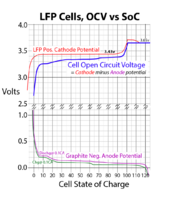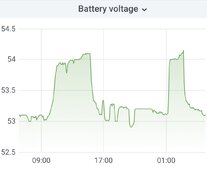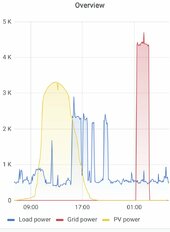RCinFLA
Solar Wizard
- Joined
- Jun 21, 2020
- Messages
- 3,565
Reason for Columb counter use is to judge SoC under cell current loading and charging conditions where there is overpotential voltage slump or bump screwing up OCV vs SoC relationship.
OCV is determined by electrode chemistry. Only thing that will effect OCV is internal leakage current that increases overpotential voltage slump to supply the leakage current. An old cell may have enough internal leakage current to effect no-load voltage from leakage current overpotential slump. Unless cell is fairly useless you will not get more than 10-15 mV of slump from fully charged OCV of 3.4 vdc from self leakage current.
At full charge, graphite anode will have a negative 10 mV to 80 mV electrode potential bringing down cell terminal voltage from LFP inherent 3.43 vdc. LFP cells are usually built with excess graphite anode capacity since graphite is the weakest link in longevity of LFP cells. SoC drift in excess negative graphite capacity may impact OCV a small amount.
OCV for LFP cell is nearly constant vs. temperature, but overpotential voltage vs cell current is very temperature dependent, getting much greater at cold temps.
Most of LFP OCV cell voltage variance versus SoC is due to negative graphite anode electrode. LFP positive cathode electrode potential is almost dead flat at 3.43vdc across 10-90% SoC. Cell OCV is positive cathode electrode potential minus negative anode potential.
The discrete graphite anode electrode potential plateaus are due to the way the lithium intercalation (cell charging lithium-ion stuffing of graphite) happens versus state of charge and is same for all lithium ion batteries using graphite negative electrodes (most lithium-ion batteries use graphite anode). The cell voltage plateaus are more pronounced during charging and less pronounced during discharging.,


OCV is determined by electrode chemistry. Only thing that will effect OCV is internal leakage current that increases overpotential voltage slump to supply the leakage current. An old cell may have enough internal leakage current to effect no-load voltage from leakage current overpotential slump. Unless cell is fairly useless you will not get more than 10-15 mV of slump from fully charged OCV of 3.4 vdc from self leakage current.
At full charge, graphite anode will have a negative 10 mV to 80 mV electrode potential bringing down cell terminal voltage from LFP inherent 3.43 vdc. LFP cells are usually built with excess graphite anode capacity since graphite is the weakest link in longevity of LFP cells. SoC drift in excess negative graphite capacity may impact OCV a small amount.
OCV for LFP cell is nearly constant vs. temperature, but overpotential voltage vs cell current is very temperature dependent, getting much greater at cold temps.
Most of LFP OCV cell voltage variance versus SoC is due to negative graphite anode electrode. LFP positive cathode electrode potential is almost dead flat at 3.43vdc across 10-90% SoC. Cell OCV is positive cathode electrode potential minus negative anode potential.
The discrete graphite anode electrode potential plateaus are due to the way the lithium intercalation (cell charging lithium-ion stuffing of graphite) happens versus state of charge and is same for all lithium ion batteries using graphite negative electrodes (most lithium-ion batteries use graphite anode). The cell voltage plateaus are more pronounced during charging and less pronounced during discharging.,


Last edited:





